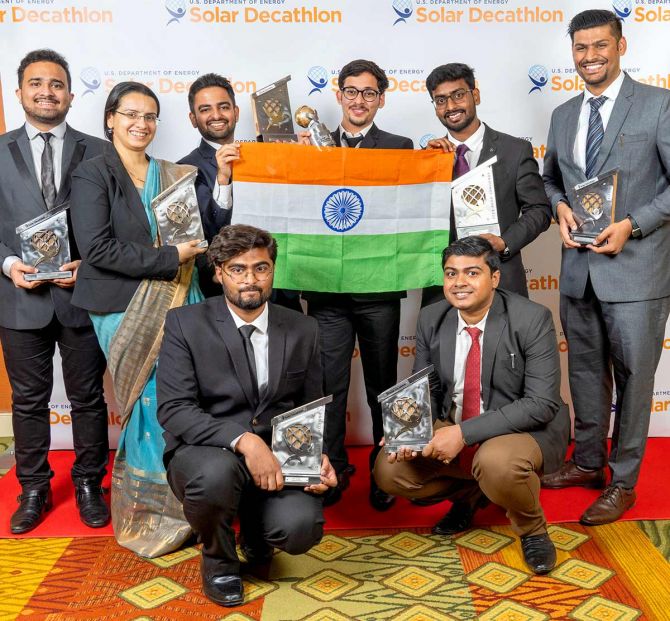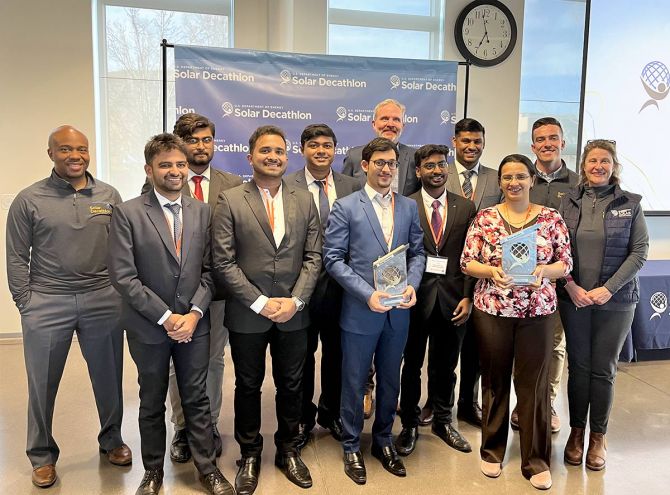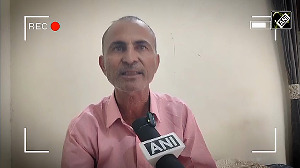Project Vivaan won big at the Solar Decathlon, placing second overall (and missing the first position by a whisker).
Members of the award-winning Team Shunya tell Mrigank Warrier how they built a carbon-neutral, water-neutral, energy-positive home for a family of four.

(Standing, from left) Jash Saravia, Professor Anupama Kowli, Inder Chhetiya, Prabhat Sharma, Dany Hemanth and Ayush Singh.
(Sitting, from left) Ali Khan and Ankan Karmakar.
All photographs: Kind courtesy Team Shunya
Picture this: An independent house that will stand for half a century and pay for itself after the first 10 years.
It generates more electricity than it consumes, reuses its own wastewater and is certified carbon-neutral.
The well-lit interiors remain cool even after the AC is switched off. And you can turn on the geyser while lounging on the sofa!
No longer a figment of imagination, this is a very concrete (but almost concrete-free) residence next to IIT-Bombay's Hostel 7.
Budding builders
Team Shunya consists of over 30 20-somethings from IIT-Bombay who spent the last 22 months planning, constructing and testing Project Vivaan, a carbon-neutral, water-neutral, energy-positive home for a family of four.
Site analysis, budgeting, blueprints, electrical and plumbing design, sustainability validation and finding sponsors -- they did it all themselves. "This was separate from our academic course load," says Project Manager Ayush Singh. "We attended lectures in the morning and worked in the evening and most nights."
Not a home alone
If you're imagining a futuristic structure that looks like something from a sci-fi novel, you're mistaken. With a total built-up area of 1,367 square feet, this ground-plus-one two bedroom-hall-kitchen looks like any other.
But it comes with amenities like a fridge, water purifier and washing machine, all of which are included in the listing price.
Gas cylinders or a piped gas connection are replaced by an induction cooking range and microwave oven, powered by solar panels on the roof. All the furniture is refurbished from old, discarded stock.
"It is a fully furnished house," says Team Leader Prabhat Sharma. "Just move in with your clothes and you can start living here."
Commissioning client
The US Department of Energy's Solar Decathlon invited college teams from across the world to design and construct a house for warm and humid conditions; the house, they said, needed to be energy-neutral, liveable, scalable and affordable.
Team Shunya -- which has participated in this 'Olympics of Sustainable Architecture' earlier as well -- set even more challenges for itself. "For example, everyone has been talking about being energy-neutral," says Prabhat. "We decided to be carbon-neutral as well."

Contemporary meets vernacular
Most urban houses today are designed according to Western sensibilities. In a return to Indian roots, Project Vivaan -- which is what Team Shunya have called their latest venture -- incorporates the central courtyard of the traditional Maharashtrian wada as a space to encourage interaction. A double-heighted living room and open kitchen allows men and women to blur stereotypical gender roles.
Depending on what direction it faces, each window is sized and placed differently to let in as much natural light and wind as possible. No cookie-cutter approach to architecture here.
C for carbon-neutrality
Conventional construction materials are manufactured from highly carbon-intensive matter. What if the building blocks of a house were produced from waste?
Team Shunya chose agro-based panels made from bagasse -- sugarcane waste which might otherwise have been burnt after crushing.
Recycled plastic and foundry waste were amalgamated into silica plastic blocks.
The steel used for reinforcement has inherent reuse value.
Every item placed inside the house was thoughtfully selected to ensure that it remains carbon-neutral throughout its existence.
Construction challenges
Project Vivaan's proposed design was one of 16 to be accepted by the competition authorities for the construction stage; Team Shunya was the only team from outside North America to qualify. But could a bunch of engineering students build a house themselves?
"Every contractor we approached said yes initially. But when we told them that we had less than 90 days for construction, they would say no," recalls Prabhat.
Dealing with the campus administration, impressing CEOs of sponsor companies and mediating minor kerfuffles between team members compounded the pressure.
Eventually, one contractor -- who was still uncertain about completing the construction on time -- agreed to come on board.
"We convinced him to just start the work. 'Build the ground floor,' we told him. 'Let's see how much we can do'," Prabhat says. "We even explained what we were trying to achieve to the construction crew so that we could persuade them to work for an extra hour, then an extra shift."
Team Shunya was hands-on during the construction process; members would take turns to perform non-hazardous tasks like putting in insulation and nailing down bolts.
Between the technical drawings for a new-fangled house and the construction crew’s traditional methods and trade lingo, much was lost in translation. Many mini-disasters had to be overcome.
"Constructing a conventional house of the same size would have taken around six months. Ours was ready in 90 days," shares Project Manager Ankush Pujari.
"Using walls prefabricated from our chosen construction materials can reduce this period even further."
Positive (on) energy
Rooftop solar panels generate electricity during the day; stored power from battery banks powers Project Vivaan at night.
The monsoon-related drop in power generation is more than offset by the surplus generated in summer.
The owner of this kind of house can also profit by selling excess electricity to the power grid.
Alternative to ACs
A chilled water system keeps the interiors cool.
Liquid desiccant -- which absorbs moisture from air -- tackles humidity.
"We wanted to develop a more energy-efficient dehumidifier," says Ayush. "Making liquid desiccant safe to use around human beings was a challenge."

No wasting water, no waste water
Low flow-rate water fixtures, rainwater harvesting and a dedicated greywater recycling unit have helped the team reduce groundwater consumption by well over 80 per cent.
Water from external sources is needed only for cooking and drinking.
Wasting the first minute of cold water that precedes hot water from a shower is an everyday crime. No more, however. Team Shunya has devised a system which delivers perfectly hot water from the very first drop.
Smart parts
The market is flooded with Smart Home software. Team Shunya went a step ahead and developed an open-source automation platform that can be customised to each home.
Want your AC to come on at a moderate temperature 15 minutes before you reach home? Done.
Want to avoid the electricity peak that comes from switching on the AC at a frigid 16 degrees Celsius as soon as you reach home? Also done.
The bottom line
The cost of just the house is more or less comparable to a conventional home.
But even after including the cost of appliances and an electric vehicle that's part of the package, this new-age home will help you earn instead -- indirectly from utilities savings and directly from sale of power.
Podium finish
It should come as no surprise that Project Vivaan won big at the Solar Decathlon, placing second overall (and missing the first position by a whisker).
"The deputy director of Colorado's National Renewable Energy Laboratory -- the host organisation -- is an IIT alumnus himself. He was so proud to see us on stage with the Indian flag," recalls Prabhat.
What's next?
More tests to track the actual performance of the house over a year and compare it to simulated values. Publish research papers. And maybe, one day, hand over the home to IIT-Bombay as a guesthouse.
"Some builders who are interested in net-zero construction have asked if we can help with the design and supervision of their projects," smiles Piyush.
But in cities of cookie-cutter highrises, where is the space for an independent house? "Our next goal is to build a ground-plus-two structure, leading up to an energy-neutral apartment building," reveals Ayush.
Easter eggs are hidden in the names the team has chosen.
Shunya stands for Sustainable Housing for an Urbanising Nation by its Young Aspirants. And Vivaan means 'ray of morning sun' -- a ray of hope for sustainable housing.
'House' that for inspiration?












